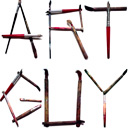 [/caption]
[/caption]I handed colored pencils to my 1st graders today.
This was not too surprizing, as I did the same thing last week. What I have noticed, however, is that most of my teachers with younger students don't let them sharpen their own pencils whenever they need to.
I, however, do. I would much rather see a student raise their hand because they're having difficulty with a portion of their composition than because their colored stick isn't pointy enough. As a result I usually announce in the beginning of the lesson that if the pencil needs sharpening, they can just get up and sharpen it. I even go so far as to explain when a pencil needs sharpening and how to sharpen it so that it doesn't disappear forever in a pile of shavings. (Colored pencils are much softer than the 2B kind.)
You know what happens next...
[caption id="" align="aligncenter" width="500" caption="Stampeeeeeede!"]
 [/caption]
[/caption]That's right, any student who found a colored pencil that was not ready to vanquish a vampire was at the sharpener ready to go! This included those who had white colored pencils. Did I mention this was a lesson where they used white paper? Well it was.
This is the point when the classroom teacher looks at me with a patronizing expression that says "That's why I don't let them do that."
And I look at them with a nervous smile that says "Eheheheh ... I'll be right back."
The next minute or so is spent turning kinds away that don't really need to sharpen pencils, as well as enforcing the "Turn it 3 times then check" rule of sharpening.
And you know what? That's it.
Occasionally a student will have a relapse, but for the most part they know my rules and what's expected of them. They're fine with that because they're getting a cool reward in the process - an awesome art project.
In fact, I wouldn't be surprised if the initial stampede was in fact because they wanted to revel in the idea that they could go and sharpen any pencil that needed it.
So how does this relate to technology integration?
You have to ask?
A new tool is a new tool, and new freedoms are promptly exercised. There will be chaos, but if you stay alert it will at least be organized chaos and learning will still be accomplished. Eventually, the chaos will be replaced with something better - a class full of students who are able to learn without raising their hands to ask permission for each step.

 Dan Meyer seems to have come across a recent theme in his lessons:
Dan Meyer seems to have come across a recent theme in his lessons: 


